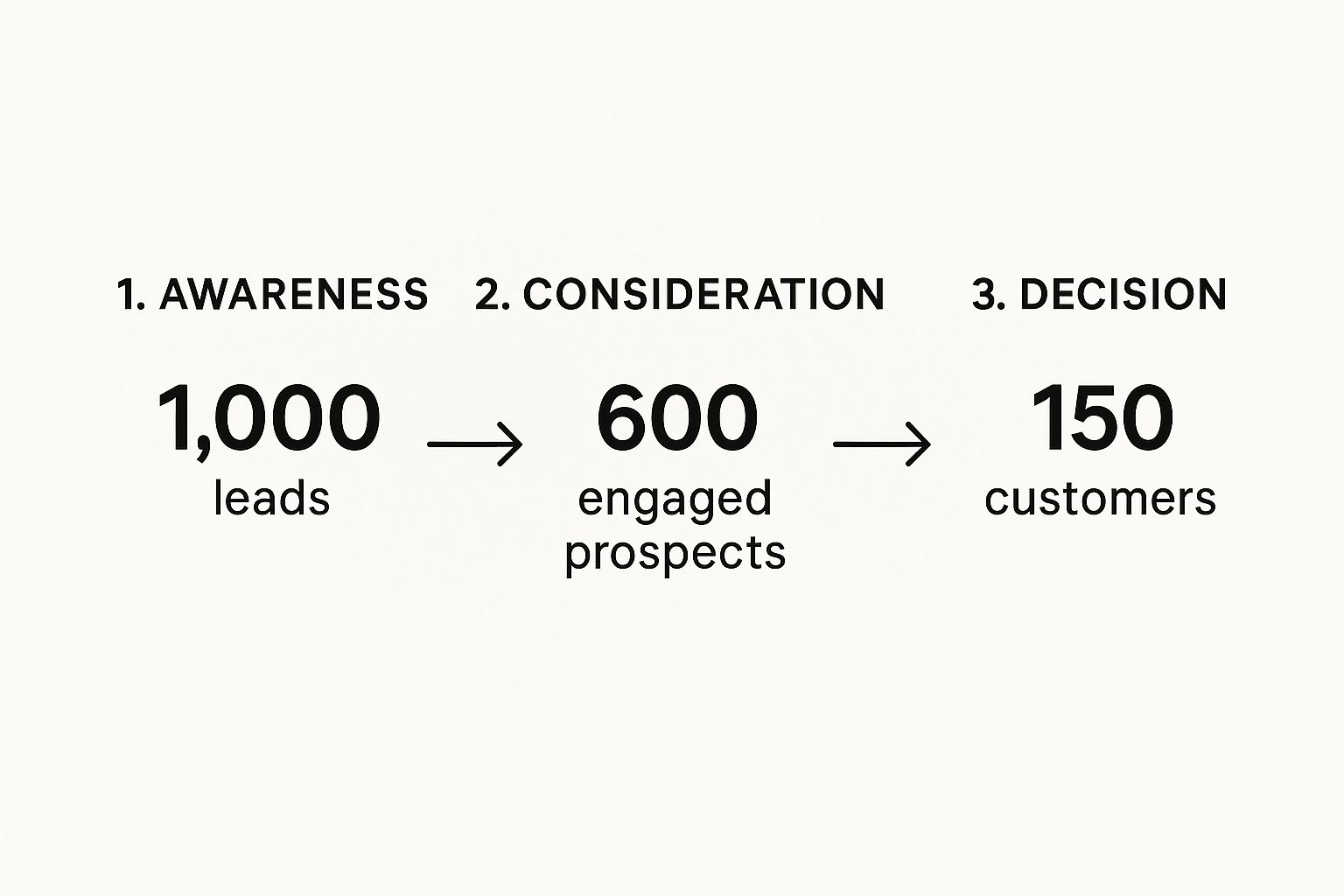When we talk about sales funnel optimization, we're not just tweaking a few steps in a rigid process. We're getting to the heart of why prospects lose interest and what actually convinces them to buy. It’s about methodically plugging the leaks in your customer's journey to stop bleeding revenue and start driving real, sustainable growth.
Moving Beyond the Traditional B2B Sales Funnel
Let’s be honest, the classic ‘Awareness, Interest, Decision, Action’ (AIDA) model feels a bit ancient in today's world. B2B buying is rarely a straight line. It's a messy, winding path where your prospects jump between multiple sources, double back on their decisions, and engage entirely on their own terms.
This is exactly why so many funnels leak money. There's a huge disconnect between the sales process we've designed and how customers actually make a purchase. You see it all the time: high-quality leads suddenly go cold after a great demo, engagement nosedives for no apparent reason, or deals stall out right before the finish line. These aren't just one-off problems; they’re symptoms of a broken funnel.
Spotting the Warning Signs
The first step is knowing what to look for. A leaky funnel leaves clues. You might be experiencing things like:
- High Lead Volume, Low Conversion: You’re great at getting eyeballs on your content, but almost nobody becomes a qualified lead or, more importantly, a paying customer. This often points to a major disconnect between your top-of-funnel message and what you're actually selling.
- Significant Drop-off Between Stages: If you see a massive dip in numbers from, say, the "Interest" to "Decision" stage, it's a huge red flag. It tells you your mid-funnel content isn't building enough trust or clearly showing your value.
- Prolonged Sales Cycles: Are deals taking way longer to close than the industry average? This usually signals friction at the bottom of the funnel. Maybe your pricing is confusing, or your proposals just aren't hitting the mark.
The impact of getting this right is massive. Companies with a well-oiled sales funnel can see revenue growth up to 18 times greater than those without a structured process. You can dig into more of the financial data behind this on ElectroIQ.
Adopting a Modern Framework
To truly optimize your sales funnel, you have to ditch the old linear model and embrace a more modern, cyclical approach. This new framework is built on data and actual customer behavior, not rigid steps someone came up with decades ago.
It also recognizes a crucial truth: the funnel doesn't just stop when a deal is signed. It extends into customer retention and advocacy, creating a powerful flywheel where your happy customers become your best source of new growth.
Building a system that focuses on the entire customer journey is the key. It's how you stop just capturing leads and start creating fiercely loyal customers who advocate for your brand. This is the foundation for plugging those leaks and achieving the predictable, scalable growth every business is after.
How to Audit and Map Your Current Funnel
You can't fix what you don't understand. And if you're trying to optimize your sales funnel, that process has to start with an honest, data-driven audit of what’s actually happening.
Too many businesses run on assumptions about their customer journey. But when you dig in, the data often tells a completely different story. To find the real leaks in your funnel, you need to become a detective, piecing together clues from different sources to map the actual paths your customers take.
This isn't about glancing at a single dashboard. It's about combining hard numbers from your CRM and analytics with the qualitative "why" from user behavior tools. Think of it as creating a complete diagnostic report for your sales and marketing engine. The goal is simple: move past how you think your funnel works and see how it really performs.
Gathering Your Diagnostic Tools
Before you can map anything, you need to collect the right intel. Start by pulling reports from the tools you're already using. Don't let it get overwhelming; just focus on the core platforms that track a customer from their first interaction to the final sale.
Your most valuable sources of information will probably be:
- Your CRM: This is your ground truth for lead progression. Look at how leads are tagged, how their status changes over time, and the conversion rates between key stages (like from Marketing Qualified Lead to Sales Qualified Lead).
- Website Analytics: Tools like Google Analytics show you the "what" and "where." Which blog posts or landing pages are pulling people in? More importantly, where are they dropping off your site?
- User Behavior Tools: This is where you get the "why." Heatmap and session recording software (think Hotjar or Crazy Egg) lets you literally watch where users get stuck, what they ignore, and what content grabs their attention.
By stitching these sources together, you get a much richer, multi-layered view. Your CRM might tell you that leads from a webinar convert well, but heatmaps can show you why—maybe the call-to-action on the webinar's landing page is perfectly placed and impossible to ignore.
This initial data-gathering phase gives you the raw material to build a visual map of your funnel's performance. You can see how many people enter at the top and how many actually make it through each stage to the bottom.
This infographic breaks down a basic conversion flow and highlights some common drop-off points.

You can see immediately where the problems are. A 40% drop-off at the awareness stage is one thing, but a massive 75% drop from consideration to decision? That’s a huge leak that needs immediate investigation.
Connecting the Dots to Find Leaks
With your data in hand, the real work begins. Your mission is to pinpoint the specific friction points where prospects either lose interest or just give up. This part requires a critical eye and a willingness to challenge your own assumptions.
Start by asking sharp, targeted questions for each stage of the funnel you've mapped out.
Top-of-Funnel Questions
- Which marketing channels are bringing in the highest-quality leads, not just the most traffic?
- Is there a disconnect between our ad copy and the landing page experience? Are we making promises we don't keep?
- What content—blogs, guides, social posts—is most effective at turning a casual visitor into a real lead?
Middle-of-Funnel Questions
- What's the average time a lead spends stuck in the "consideration" phase? Is it days? Weeks?
- Which deeper-funnel assets, like case studies or whitepapers, are actually being consumed by active prospects?
- At what specific point do our sales follow-ups stop getting responses?
This kind of detailed inquiry helps you move from vague problems ("our mid-funnel is weak") to specific, testable hypotheses ("prospects who view our pricing page but don't request a demo are going cold within 48 hours").
This is where more advanced platforms like Google Analytics or Mixpanel really shine. They let you track metrics like click-through rates, conversion rates, and customer lifetime value (CLV) in real time. These numbers illuminate exactly how leads are interacting at each stage, helping you find where they drop off or engage more deeply. If you want to dive deeper, Number Analytics has a great post on expert ways to optimize sales funnels for growth.
Ultimately, a thorough audit gives you a data-driven blueprint. It shines a spotlight on your funnel's biggest vulnerabilities and, more importantly, its greatest opportunities for quick wins. This map becomes your guide for targeted, effective optimization.
Focusing Your Funnel on High-Quality Leads

We've all heard the old saying "garbage in, garbage out." It's never been more true than at the top of a B2B sales funnel. Sure, attracting a flood of low-quality traffic might give your vanity metrics a nice little boost, but it does more harm than good. It clogs your pipeline and wastes your sales team's precious time.
Real sales funnel optimization starts by attracting the right people from the get-go.
It’s about shifting your mindset. Stop casting a wide, flimsy net and start using a powerful, focused magnet. Your job isn't just to generate traffic; it's to pull in high-intent prospects who already know they have a problem and are actively looking for a solution. This is how you ensure the leads you pass down the funnel are actually qualified and ready for a real conversation.
Create Content That Solves Problems
The single best way to attract your Ideal Customer Profile (ICP) is to create content that speaks directly to their biggest headaches. I’m not talking about thinly veiled product pitches. I mean providing genuine, expert value that establishes your authority. Forget the generic blog posts and focus on creating deep-dive assets that solve a specific, painful problem for your audience.
Here are a few high-impact formats I’ve seen work wonders:
- In-depth Guides and Whitepapers: A truly comprehensive guide on a niche industry challenge immediately positions you as an expert. For example, a cybersecurity firm could publish a detailed guide on "Implementing a Zero-Trust Framework in a Hybrid Workforce."
- ROI Calculators and Assessment Tools: Interactive tools give people immediate, personalized value. A logistics company could offer a calculator that estimates potential savings from route optimization. This instantly frames your solution in terms of cold, hard business outcomes.
- Industry-Specific Webinars: Host a live session that drills down on a unique pain point for a vertical you serve. A marketing automation platform might run a webinar on "Lead Nurturing Strategies for SaaS Companies," packed with real-world examples and data.
The key principle is to align your content with where the buyer is in their journey. At the top of the funnel, they are problem-aware, not solution-aware. Your content has to meet them there, helping them understand their problem better before you even whisper your product's name.
This approach naturally weeds out anyone who isn't struggling with the specific issues you solve, leaving you with a much richer pool of qualified leads. To really dial this in, exploring well-structured demand generation campaigns is a fantastic next step.
Target High-Intent, Bottom-of-Funnel Keywords
While top-of-funnel content builds awareness, your SEO strategy needs to get aggressive with keywords that scream "I'm ready to buy!" We call these bottom-of-funnel (BOFU) keywords, and they show a user is much closer to pulling the trigger.
Just think about the specific phrases someone types in when they've finished their general research and are now actively comparing their options.
Examples of High-Intent BOFU Keywords:
- "Salesforce vs. HubSpot pricing"
- "Best B2B lead generation software"
- "Salesloop.io alternatives"
- "[Your Competitor] implementation guide"
Building content around these terms—like detailed comparison pages, "alternative-to" guides, and transparent pricing breakdowns—lets you intercept prospects at a make-or-break moment. You catch them right when they're evaluating solutions, giving you the perfect opening to state your case.
This approach won't bring in the same volume of traffic as broader keywords, but the leads it generates are infinitely more valuable and tend to have much shorter sales cycles. Our own guide to B2B sales lead generation dives deeper into blending these SEO tactics with other outreach methods.
Design Landing Pages That Convert
Finally, where you send all this high-intent traffic is just as critical as how you attract it. Every piece of valuable content needs its own dedicated landing page, and that page should be mercilessly optimized for one thing and one thing only: conversion.
A high-converting landing page is completely free of distractions. That means no main site navigation, no footer links, and nothing else that could pull a visitor's attention away from your call-to-action (CTA).
Your landing page must have:
- A Compelling Headline: It has to match the promise of the ad or link they clicked and clearly state the value of what you're offering.
- Concise, Benefit-Oriented Copy: Use bullet points. Make it scannable. Focus on what they gain by downloading your guide or joining your webinar.
- Social Proof: Slap on a key customer logo, a powerful testimonial, or an impressive stat to build instant trust.
- A Simple Form: Only ask for what you absolutely need. For every extra field you add, you can expect your conversion rates to drop by up to 11%.
- A Clear CTA Button: Use action-focused text like "Get My Guide" instead of a boring "Submit."
By building your strategy on these three pillars—problem-aware content, intent-driven SEO, and conversion-focused landing pages—you create that powerful magnet at the top of your funnel. This is how you make sure the leads flowing into your sales process are not just plentiful, but profitable.
Mastering the Mid-Funnel with Strategic Nurturing
So, you’ve grabbed a prospect's attention. Great. Now the real work starts.
The middle of the funnel is a delicate balancing act. This is where you either forge a real relationship or lose the deal entirely. Your one job here is to guide interested prospects to the point where they're absolutely convinced you're the right solution—all without scaring them off with a pushy sales pitch.
Effective mid-funnel strategy is all about smart, value-driven nurturing. It’s about building trust, showing off your expertise, and proving your worth in real, tangible ways. Frankly, this is where a lot of businesses drop the ball, letting perfectly good leads slip away simply because their follow-up game is weak.
Crafting Automated Yet Personal Email Sequences
Let's be honest, the email nurture sequence is the backbone of most mid-funnel strategies. But a generic, one-size-fits-all email blast is a one-way ticket to the trash folder. The secret is creating automated sequences that feel personal and deliver value at the right time, based on what the prospect actually does.
Picture this: a prospect just downloaded your detailed guide on a specific industry problem. Instead of a bland "Thanks for your download" email, you trigger a sequence that builds on that spark of interest.
- Email 1 (Day 1): Send them the guide, but also include a quick, genuinely helpful tip related to the content.
- Email 2 (Day 3): Follow up with a short case study about a similar company that solved the exact problem from the guide.
- Email 3 (Day 7): Invite them to a webinar that goes even deeper into that topic.
- Email 4 (Day 12): Gently introduce a feature of your product that directly solves their problem. Frame it as a helpful solution, not a hard sell.
See the difference? You’ve just turned a simple follow-up into an educational journey.
Deploying High-Impact Content to Build Trust
Mid-funnel content has to do more than just educate; it must build rock-solid trust and answer the questions your prospects are asking themselves while they size you up. You're shifting from content that defines the problem to content that presents the solution.
Competitor Comparison Sheets: Your prospects are 100% checking out your competitors. Don't hide from it. Create honest, fair comparison sheets that play to your unique strengths. Being transparent about where you excel (and maybe even where you’re not the best fit) builds massive credibility.
Targeted Case Studies: A well-placed case study is one of the most powerful tools you have. But relevance is everything. If a prospect from the manufacturing industry is looking at your inventory management features, you need to hit them with a case study about how another manufacturing company fixed their inventory mess with your product.
This is exactly why a solid nurturing process is so critical. The data shows that companies who nail lead nurturing generate 50% more sales-ready leads while spending 33% less to acquire them. And yet, a staggering 79% of marketing leads never convert, mostly because of poor nurturing. You can dig into more of the data behind effective nurturing on Cropink.
This points to a huge opportunity. By focusing on strategic, consistent engagement, you can scoop up all the value your competitors are leaving on the table.
Automating Personalized Outreach at Scale
Let's get real—manually tracking every single prospect and sending them tailored content is a nightmare. It's just not possible to do it well as you grow. This is where automation platforms become your best friend. Tools like Salesloop.io are built for this, letting you create sophisticated, multi-channel outreach campaigns that run on autopilot.
For instance, you can easily set up a campaign in Salesloop.io to find and engage prospects based on specific job titles within your target companies.

This screenshot shows just how simple it is. You can add job titles like "Head of Sales" or "VP of Marketing" to a campaign, which makes sure your carefully crafted messages only land in front of the decision-makers you actually want to talk to. From there, the platform automates finding these people and adding them to the right messaging sequence.
This level of targeted automation ensures your most engaged leads get the right message at the right time. It stops valuable prospects from falling through the cracks because of slow or generic follow-up, turning your mid-funnel into a well-oiled machine that builds trust and moves leads toward a sales call.
Bringing High-Intent Leads Across the Finish Line

You’ve done the hard work. You guided a prospect from just being aware of you to seriously considering you as a solution. They know your name, they trust what you have to say, and they see you as a real contender.
This is the moment of truth. The bottom of the funnel (BOFU) is where the deal is either won or lost. Even the smallest hiccup or bit of friction can be enough to make a very interested lead change their mind and walk away.
Success here is all about one thing: making the decision to buy from you as easy and reassuring as possible. Your job is to clear every obstacle, answer every last-minute doubt, and give them the gentle nudge they need to sign with confidence. This is where your sales funnel optimization efforts really pay off.
Make Your Pricing and Proposals a No-Brainer
Nothing kills a deal faster than confusion. When a prospect is finally ready to talk numbers, your pricing page needs to be crystal clear. Ditch the jargon and overly complex tiers. Instead, spell out the value of each plan and who it's designed for.
The same rule applies to any custom proposals you send. A great proposal isn’t just a list of prices; it’s a strategic document that proves you're the solution to their specific problems.
- Echo their pain points. Kick things off by summarizing the exact challenges they told you about. It shows you were paying attention and you get it.
- Connect your features to their goals. Don't just list what your product does. For every feature, explain how it solves one of their pains or helps them hit a target.
- Lay out clear next steps. Show them exactly what happens next, from signing the contract to getting onboarded. Make it feel simple and totally manageable.
The idea is to frame this decision not as a cost, but as a smart, logical investment to stop a problem that’s already costing them.
Run Demos That Actually Solve Problems
By the time you're doing a demo, your prospect doesn't need a grand tour of every single button in your software. They have a specific problem, and they want to see if your product can fix it. Period. A demo that converts is a problem-solving workshop, not a feature showcase.
Before you even jump on the call, go back through your notes. Pinpoint the top two or three challenges they’re wrestling with. Then, build your entire demo around showing them exactly how your product crushes those specific issues.
A classic mistake is treating a demo like a training session. Don't. You want to focus on creating "aha!" moments. Show them the solved problem first, then quickly show how simple it was to achieve. Keep it punchy and focused on their win.
This personalized approach makes your value proposition hit home. It shifts the conversation from, "So, what does your software do?" to "Okay, when can we get started?" To see how this fits into the bigger picture, check out our guide on building a powerful inbound sales funnel.
Smooth Out the Final Steps and Handle Objections
Even the most excited prospects can get cold feet right at the end. It's your job to proactively remove any final friction points and be ready for those last-minute questions.
Think through their final steps. Is your contract a wall of dense legal text? See if you can simplify it. Is your checkout process clunky? Modernize it. Sometimes, a tiny detail can be the clincher. For example, adding a powerful testimonial right on your pricing or checkout page can be the final dose of social proof a hesitant buyer needs.
When an objection pops up—about price, implementation, whatever—don't get defensive. Hear them out and ask questions to get to the real issue. An objection is often just a plea for more information or reassurance. Have things like implementation plans, ROI case studies, or security docs ready to go.
And for those who go quiet right at the one-yard line? A solid follow-up sequence is key. These last few nudges should be helpful, not just pushy. Offer another resource or a final chance to connect. That thoughtful persistence is often what it takes to turn that prospect into your newest customer.
Turning Customers Into a Growth Engine
So many businesses treat a signed contract like the finish line. It's a huge mistake. True sales funnel optimization is about what happens after the initial sale. This is where you have the chance to turn one-time buyers into your most powerful growth engine—if you play your cards right.
This often-overlooked stage is all about building loyalty and creating a flywheel. Your focus has to shift from pure acquisition to retention and, ultimately, to advocacy. Think about it: a happy, successful customer isn't just a source of recurring revenue. They're your most authentic and effective marketing asset.
Nail the Onboarding Experience
Those first 90 days are everything. This is your one shot to prove your product's value and make the customer feel brilliant for choosing you. A clunky, confusing, or unsupported onboarding experience is a one-way ticket to churn.
A great onboarding isn't just about sending a login and a link to a help doc. You need to be proactive and obsessed with delivering value from day one.
- Offer a personalized kickoff call: Don't just demo the product; walk them through a setup tailored to their specific goals.
- Create a "first wins" checklist: What are the three things they can do in the first hour to see an immediate result? Guide them there.
- Use smart in-app tutorials: As they explore new features, give them contextual tips right when they need them. No one wants to hunt through a knowledge base.
Get this initial period right, and you've laid the foundation for the entire relationship. A customer who has a great start is far more likely to stick around and listen to what you have to say later.
Build Robust Feedback Loops
Do you actually know what your customers think? Just because no one's complaining doesn't mean everything's perfect. That's a dangerous assumption. You have to actively go out and ask for feedback to make customers feel heard and to gather priceless insights for your product roadmap.
Set up structured ways for them to share their thoughts. This could be regular check-in calls, simple in-app surveys, or even an exclusive customer community on Slack or Circle.
The key is to close the loop. When you get feedback, acknowledge it fast. And when you actually implement a suggestion, circle back and let that customer know their idea made a real difference.
When customers feel like they're partners in your product's journey, their loyalty skyrockets. They stop being just users and become invested stakeholders who genuinely want you to win.
Improving the entire customer journey is a big project. For a wider view that complements these post-sale tactics, check out our guide on sales process optimization.
Identify Natural Upsell and Cross-Sell Opportunities
Growing an existing account is infinitely cheaper and easier than landing a new one. The trick is to spot upsell and cross-sell moments that feel helpful, not greedy. This means you have to pay attention to how they're using your product and what their business is trying to achieve.
For example, is a customer constantly bumping up against the usage limits of their plan? That's the perfect, non-salesy time to show them the value of the next tier up. Are they having massive success with one of your products? Think about what other related problem you can solve for them with another offering.
This isn't about squeezing more money out of them; it's about strategic account growth that turns them into genuine long-term partners.
Ultimately, you're aiming to create a virtuous cycle. A delighted, supported customer is far more inclined to:
- Give you powerful testimonials and case studies.
- Refer new, high-quality leads from their own network.
- Become a vocal brand advocate on social media and review sites.
This is the holy grail of sales funnel optimization—when your own customers start filling the top of your funnel for you.
Got Questions About Sales Funnel Optimization? Let's Clear Things Up.
When you're deep in the weeds of optimizing your sales funnel, it's natural for questions to pop up. Getting straight answers is the only way to cut through the noise, sidestep common traps, and actually make progress.
A big one I hear a lot is about the difference between a sales funnel and a flywheel. It’s simpler than it sounds.
Think of a funnel as a linear path to get a customer—moving them from just hearing about you to signing on the dotted line. A flywheel, on the other hand, is a cycle. Happy customers create momentum that spins off new growth through referrals and repeat business. The best strategies don't pit them against each other; they use the funnel to land the customer and the flywheel to make them so happy they become your best salespeople.
How Often Should I Be Looking at My Funnel?
Another question that comes up constantly is how often to audit the funnel. While a massive, deep-dive audit is great to do quarterly to catch big-picture trends, you can't just set it and forget it for three months.
You need to keep a much closer eye on your funnel's vital signs. Metrics like your stage-by-stage conversion rates and how quickly leads are moving through should be on your radar weekly, or bi-weekly at the absolute latest. This constant pulse check helps you plug small leaks before they turn into gushing holes in your revenue.
So, what are the most critical numbers for a B2B funnel? I always tell teams to zero in on the metrics that prove efficiency and impact.
- Lead-to-MQL Conversion Rate: This tells you if your top-of-funnel efforts are even attracting the right people.
- MQL-to-SQL Rate: This is your gut check for marketing and sales alignment. Are they on the same page about what a "good lead" is?
- Sales Cycle Length: A long sales cycle is a direct symptom of friction somewhere in your process.
- Customer Lifetime Value (CLV): This is the ultimate report card for your funnel's long-term health and profitability.
What If Leads Are Getting Stuck in the Middle?
Finally, let's talk about a classic problem: your top of funnel is packed, but prospects just seem to lose interest and stall out somewhere in the middle. Almost every time I see this, it points straight back to a weak or non-existent nurturing strategy.
The fix isn't more generic "just checking in" emails. It's about shifting to targeted, high-value content that actually helps the prospect.
You need to build and send out assets that matter at this stage—things like super-specific case studies, detailed guides comparing you to a competitor, or webinars that solve a real problem they're facing. These pieces don't just sell; they build trust. An automated email sequence that intelligently delivers this content based on what a prospect does is your secret weapon for guiding them confidently to a decision.
Ready to stop leads from stalling and put your outreach on autopilot? Salesloop.io gives you the tools to build and run powerful, multi-channel campaigns that actually nurture prospects and get meetings booked. Learn more and start your campaign with Salesloop.io.





